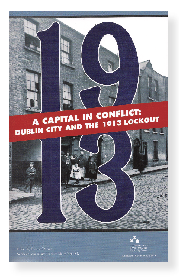A capital in conflict: Dublin City and the 1913 Lockout
Published in 1913, 20th Century Social Perspectives, 20th-century / Contemporary History, Book Reviews, Issue 4 (July-August 2013), Reviews, Revolutionary Period 1912-23, Volume 21, World War IFrancis Devine (ed.)
(Four Courts Press, €24.95)
ISBN 9781907002106
 The centenary of the Lockout has generated a new interest in the period that goes beyond just historians and trade union activists. With James Plunkett’s remarkable novel Strumpet city on the lips and minds of many Dubliners thanks to the ‘One City, One Book’ campaign, there is a popular interest in the events of that dark episode in Dublin’s past.
The centenary of the Lockout has generated a new interest in the period that goes beyond just historians and trade union activists. With James Plunkett’s remarkable novel Strumpet city on the lips and minds of many Dubliners thanks to the ‘One City, One Book’ campaign, there is a popular interest in the events of that dark episode in Dublin’s past.
This collection, edited by Francis Devine, brings together a mix of well-established Irish labour historians and new voices. Devine’s impressive output in recent years with the Irish Labour History Society has established him as a leading figure in Irish labour history studies, and here he has compiled a series of thought-provoking essays which look not only at the leading events and protagonists of the Lockout but also at broader questions like commemoration and the existing historiography around the event.
He opens with a wide-ranging chapter that presents a number of reflections on the Lockout, provides crucial introductory information on the leading protagonists and attempts to give an idea of social conditions and industrial relations in the Dublin of the time. He also sets the event in the context of the period defined as the ‘Irish Revolution’, and one of his most interesting observations is that in 1918 the ITGWU stressed the significance of the Easter Rising rather than the Lockout for the rapid ascent of the union, noting that ‘It linked up the Labour Movement with the age-long aspirations of the Irish people for emancipation from political and social thraldom’. While it is often said that when labour marched into the GPO they never emerged again, it appears that some in the labour movement felt that the Rising had a positive effect on the union movement.
William Martin Murphy has been reduced to a comic villain in the popular narrative, but Thomas J. Morrissey’s article, like his biography, provides insights into a very complex figure. William ‘Murder’ Murphy, as the labour movement christened him, tends to fall into obscurity in the aftermath of his victory in 1914, but Morrissey details his work in Irish nationalist politics in the years after the Lockout. Morrissey writes that Murphy confided in his friend T.M. Healy how he slept soundly during the great strike but had sleepless nights at the prospect of the partition of Ireland. A vocal opponent of conscription, it is perhaps ironic that the 1918 general strike against conscription in Dublin saw the trade union movement flexing its muscles in a way it hadn’t managed to do in the years since the Lockout.
In these early stages of the ‘decade of commemoration’, a term some of us are tiring of already, John Cunningham’s article on the ‘history wars’ around the Lockout has particular relevance today. Cunningham looks at how the event was marked, or in some cases not marked, in the years and decades which followed it. His article focuses on the public history of the Lockout as opposed to academic scholarship, and he notes that the ‘epic character’ of the Lockout was recognised in the immediate aftermath of events, with contemporary figures wasting little time in trying to shape the narrative. Cunningham looks at Arnold Wright’s Disturbed Dublin, which was published in London in 1914 and in many ways has come to be seen as the employers’ account. Cunningham concludes that this work, praised in the pages of the Irish Independent as an ‘impartial history of last year’s great labour upheaval that ended in the glorious defeat of an insidious attempt to establish a vicious form of Continental Syndicalism’, was ‘propagandist in design, but in its transparent one-sidedness it was ineffective propaganda’. If Disturbed Dublin was condemned by some on the basis of its bias, Cunningham demonstrates that the same treatment was given to the novel Strumpet city decades later, with police historian Gregory Allen lambasting the portrayal of the Dublin Metropolitan Police and insisting that ‘the police in every age standing against the outcry of radical forces for absolute freedoms in society are at the mercy of articulate minorities, including some writers, who succeed at least in perpetuating the old bogeyman image of the police’.
Other issues addressed range from the relationship between the union movement and the nationalist movement at the time to the ill-fated (and ill-conceived?) plan to send the children of striking families to England. Another particularly interesting article relates to the sacking of Guinness boatmen during the dispute. This article emerged from discussions between Patrick Coughlan and Francis Devine. Coughlan, a retired Guinness worker, is a descendant of a boatman sacked during the dispute, and this bit of family history shines a light on the Guinness company, too often viewed through rose-tinted glasses as an almost perfect employer. Readers of Martin Duffy’s The trade union pint (Liberties Press, 2012, reviewed on p. 63) will learn that it took a younger Jim Larkin to bring organised unionism into that workplace in a serious long-term manner.
While some of the topics and themes addressed may be well-trodden ground academically, the book really delivers when it addresses the popular memory and perceptions of the labour dispute. It is a welcome contribution to the centenary year of that great and tragic chapter in Dublin’s history. HI
Donal Fallon is co-editor of Dublin life and culture blog ‘Come Here To Me’.
















